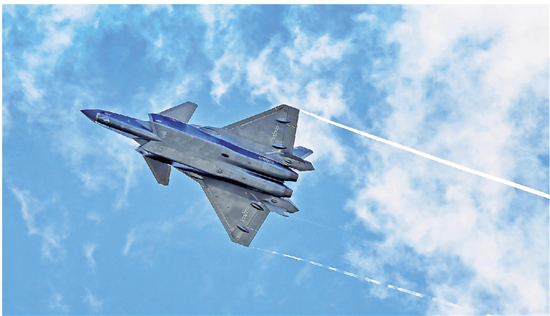By Tom McGregor, CCTV.com Panview commentator and editor
You can define a nation's strength by its defense. The country's Armed Forces - Army, Marines, Navy, Coast Guard and Air Force - must stay strong, speedy and stealth to protect its citizens and win wars when commanded to do so.
The military serves a vital role to prevail against aggression. The nation's Armed Forces can not succeed just by size alone - strength in numbers. Troops must also come equipped with the most-advanced weaponry.
Weapons must provide big-time firepower with state-of-the-art tech. innovations to achieve success on the battlefield. The Army needs overwhelming naval and air power to provide cover for soldiers fighting on the ground.
Accordingly, China's People's Liberation Army Air Force (PLAAF) has introduced a new fifth-generation fighter jet - Chengdu J-20.
Official public introduction
The Chengdu J-20 came to the public’s view in November 2016 at the Zhuhai Air Show, China’s biggest annual event to showcase the latest civilian and military aircraft developed in the country.

(File photo of J-20 Photo from Xinhua)
The pair of Chengdu J-20s had conducted a 60-second flyover, while observers said its thundering roar had been so loud, car alarms in the parking lot were set off.
The fighter jets were designed with radar-evasion stealth technology, alongside carrying air-to-air missiles.
"It is clearly a big step forward in Chinese combat capability," Bradley Perrett of Aviation Week told the BBC News.
Many military aviation experts are comparing it positively to US-based Lockheed Martin's F-22 Raptor Jet, which is considered the most advanced stealth aircraft in the world.
PLAAF-approved fighter jets
General He Weirong, the then deputy commander of PLAAF, has played a leading role in the development of the stealth fighter jet from the initial stage.
The PLA had signed up Chengdu Aerospace Corporation (CAC) as chief builder and designer of the J-20.
The J-20 had performed many rounds of flight tests, as well as various aerial formations exercises. But despite its grand introduction at the 2016 Zhuhai Air Show, few J-20s have been set for operations.
The PLA hopes to jumpstart production lines, but the costs have already exceeded $US100 million per jet. Although still cheaper than the F-22 Raptor Jet, Chinese producers of J-20s are looking to streamline costs, while ensuring the fighter jets remain battle-ready.
Designing for innovation
The PLAAF had conducted the successful maiden flight test of the Chengdu J-20 on January 2011. Ever since then, numerous flight tests were conducted. On March 2014, a first flight test of its prototype aircraft was also successfully conducted.
Chinese netizens had posted photos of the fighter jet in flight mode.Although the photos failed to capture close-up details of the Chinese-made stealth jet, many defense experts acknowledged Chinese stealth technology is beginning to catch up with that of the USA.
In an interview with Bloomberg News, the former US Secretary of Defense Robert Gates said Chinese fighter jets are making advances at a faster pace than he had previously anticipated.
Gates appeared in Beijing to witness the J-20's maiden flight on January 11, 2011.
The chief designer of the aircraft was Yang Wei, who also led the design team to build the CAC/PAF JF-17 Thunder fighter jet. The J-20 stealth aircraft has a twin-engine with an angular design that coincides with a wind tunnel model, showing twin-vertical tail fins.
Achieving 'low observables' mode
Defense experts from Australia had overheard high-level US military officials working for then US President Barack Obama boasting American-made weapons technology are far superior to any other countries' capabilities and unlikely to be surpassed for the next few decades to come.
The Australian experts were shocked by the Pentagon's arrogance and decided to take a closer look at the Chengdu J-20 and post a report on their technical analysis on a blog, AirPowerAustralia, dated July 4, 2011.
They viewed photos of the J-20 posted by Chinese netizens and concluded, Chinese designers could be even more advanced in stealth technology than anyone else has imagined.
For fighter jets, stealth, recognized in military terms as 'low observables,' can only be achieved by "shaping, shaping, and shaping the materials."
Meanwhile, the fighter jet's nozzle, which is the most difficult part to avoid radar detection, appears to have been designed "to lower radar hot spots."
The Australian experts heard the Chinese design team has used 'Top Secret' materials to minimize radar detection. No outsider has identified the materials, but they have been proven effective.
Catching up with USA
The Australian experts have good reason to express dismay with Pentagon officials during the Obama Era. They appeared overly-optimistic about the military technology capabilities of the US Armed Forces weaponry.
Even if such notions had an element truth, it's the obligations of all armies to continue to get stronger and more innovative. Arrogance breeds laziness and soon rivals can catch up.
The Chengdu J-20 stealth fighter jet stands as proof positive the PLAAF has made major headway to introduce new aircraft that can avoid radar detection, while still packing a powerful punch to attack an enemies’ land and naval forces.
Does the PLAAF offer superior technology than the US Air Force at the moment? Perhaps not, but we could have a different answer to that question 10 years later.
( The opinions expressed here do not necessarily reflect the opinions of Panview or CCTV.com. )

Panview offers a new window of understanding the world as well as China through the views, opinions, and analysis of experts. We also welcome outside submissions, so feel free to send in your own editorials to "globalopinion@vip.cntv.cn" for consideration.
















